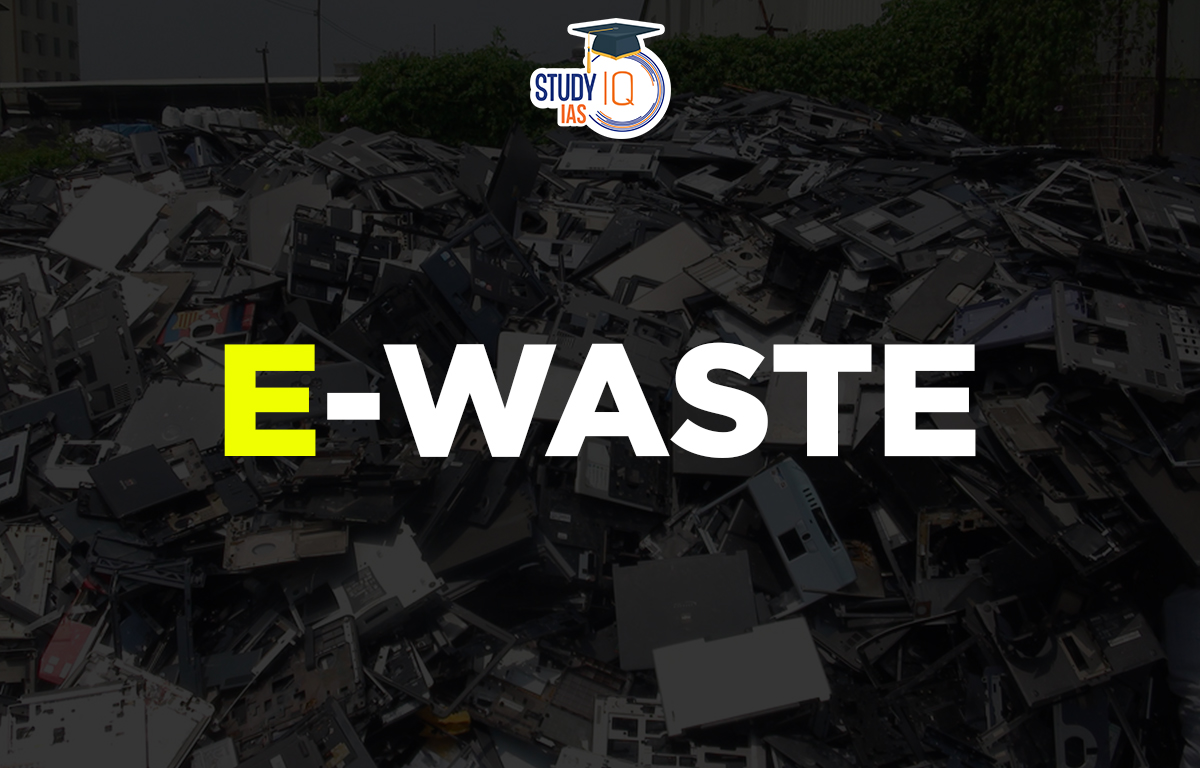Table of Contents
Context: Around 25,000 workers including children are involved in crude dismantling of e-waste in Delhi, without any protective gears.
E-Waste Situation
- According to the Global E-waste Monitor 2020, the world dumped 53.6 million metric tons of e-waste in 2019.
- Global e-waste generation is projected to grow to 74.7 million tonnes by 2030.
- India produced 3.2 million metric tons of e-waste, much of which is dumped for dismantling and recycling with no regulations.
E-Waste
- It is commonly defined as “electrical or electronic equipment which is waste, including all components, subassemblies and consumables, which are part of the equipment at the time the equipment becomes waste”.
E-Waste (Management) Rules 2022
- Restricted the use of hazardous substances (such as lead, mercury, and cadmium) in manufacturing electrical and electronic equipment that have an adverse impact on human health and the environment.
- Targets fixed: Producers of electronic goods have to ensure at least 60% of their electronic waste is collected and recycled by 2023 with targets to increase them to 70% and 80% in 2024 and 2025, respectively.
- Extended Producer Responsibility Certificates (similar to carbon credit mechanism): This will allow the offsetting of e-waste responsibility to a third party.
- ‘Environmental compensation’ to be provided by the companies that don’t meet their target.
- Role of State Governments: They will earmark industrial space for e-waste dismantling and recycling facilities, undertaking industrial skill development and establishing measures for protecting the health and safety of workers engaged in the dismantling and recycling facilities for e-waste.
- Role of Central Pollution Control Board: It shall conduct random sampling of electrical and electronic equipment placed on the market to monitor and verify the compliance of reduction of hazardous substances provisions.
E-Waste and Children
- An estimated 152 million children aged 5–17 years are involved in child labour, including 11.9% in the industrial sector, which includes waste processing.
- Some 73 million children worldwide engage in hazardous labour, with unknown numbers in the informal waste recycling sector
- E-waste recycling work can be considered child labour as it is potentially detrimental to children’s physical and mental development.
- Children as young as 5 years of age have been reported working in the sorting, dismantling and recycling of e-waste.
Harmful Effect of E-Waste on Children
- E-waste can be harmful to the health of humans and the environment if it is recycled inappropriately and without sufficient training, protection, infrastructure, equipment or safeguards.
- Children are more vulnerable than adults to toxicants released through e-waste due to their smaller size, less developed organs and rapid rate of growth and development.
- E-waste exposure has been linked to a variety of adverse health outcomes, including impaired neurological and behavioural development, negative birth outcomes and immune system impacts.

- Chronic exposure to e-waste and its toxic components violates children’s rights.
- For many children, lack of access to an appropriate justice system or an effective remedy further violates their human rights.
- By endangering tens of millions of children and women of childbearing age, improper disposal of e-waste threatens the health and abilities of future generations.
Way Forward
- Implementing laws: Government should ensure effective implementation of existing laws on child protection and waste management.
- This can be achieved only if different agencies like children’s rights groups work closely with other departments, like district-level administration.
- Safety of e-waste collectors: Ensuring health and safety of e-waste workers and communities with systems that train and protect workers, monitor exposure and health outcomes, and make protecting children the highest policy priority;
- Best health practices: Enforcing sound environmental health practices for disposal, recapture and reuse of materials;
- Circular economy: Shifting toward a circular economy by manufacturing more durable electronic and electrical equipment, using safer and less toxic materials, and encouraging sustainable consumption to reduce e-waste;
- Child labour elimination: Eliminating child labour and incorporating adult e-waste workers into the formal economy with decent conditions across the value chain of collection, processing and recycling, and resale by transitioning informal workers to the formal economy.
- Managing e-waste by prioritizing health and environmental protection throughout the life cycle, with reference to the Basel Convention, appropriate regional conventions and the Sustainable Development Goals (SDGs) on waste management.



 100 Years of CPI: Origins, Ideology, Fre...
100 Years of CPI: Origins, Ideology, Fre...
 Santhali Language: History, Script, Cons...
Santhali Language: History, Script, Cons...
 How African Reserves Eliminated Rhino Po...
How African Reserves Eliminated Rhino Po...

























